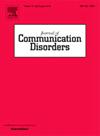Mapping 74 years in acoustic analysis of voice disorders: A bibliometric review and future research directions
IF 2.1
3区 医学
Q2 AUDIOLOGY & SPEECH-LANGUAGE PATHOLOGY
引用次数: 0
Abstract
Purpose
This paper conducts a bibliometric analysis to identify and examine the strengths, gaps, and trends in research on acoustic voice assessment for voice disorders.
Methods
A bibliometric analysis was performed on journal articles about voice disorders and acoustic voice assessment in English, Spanish, and Portuguese using seven indexed databases. The analyzed bibliometric parameters included publication year, authors, institutions, countries, journals, subject areas, and keywords. VOSviewer software was used for keyword co-occurrence analysis and authorships network analysis. The initial search yielded 6532 publications, with 1253 relevant papers after screening (1951–2024).
Results
Publications in acoustic voice assessment had 74 years of exponential growth (25 % published after 2021). The publishing journals covered 80 categories and subjects. Artificial Intelligence, though recent, was among the top journal subjects. Health conditions like dementia, Alzheimer’s, Amyotrophic lateral sclerosis, and depression were underassessed compared to Parkinson’s. The literature focused on four separate themes: physiology of voice-affecting conditions; speech acoustics for evaluating dysphonia; speech production measurements for treating voice disorders; machine learning integration for voice disorder assessment.
Conclusions
Taking a wide view of acoustic voice assessment demonstrated research strengths and gaps—highlighting where it is used and not used—and the co-occurrence of various voice assessment topics. These insights reveal future opportunities to implement acoustic voice assessment.
74年来声音障碍声学分析的制图:文献计量学回顾和未来研究方向
目的本文通过文献计量学分析来识别和检查语音障碍声学语音评估研究的优势、差距和趋势。方法使用7个索引数据库,对英语、西班牙语和葡萄牙语有关语音障碍和声学语音评估的期刊论文进行文献计量学分析。分析的文献计量参数包括出版年份、作者、机构、国家、期刊、学科领域和关键词。使用VOSviewer软件进行关键词共现分析和作者网络分析。最初检索到6532篇论文,筛选后相关论文1253篇(1951-2024)。结果声学语音评价的出版物呈指数增长74年,其中25%是在2021年以后发表的。出版期刊覆盖80个门类和学科。人工智能虽然是最近才出现的,但却是最热门的期刊主题之一。与帕金森病相比,痴呆、阿尔茨海默病、肌萎缩侧索硬化症和抑郁症等健康状况被低估了。这些文献集中在四个不同的主题上:影响声音条件的生理学;语音障碍评价的语音声学;用于治疗语音障碍的言语产生测量;语音障碍评估的机器学习集成。结论:对声学语音评估的广泛研究表明了研究的优势和差距——突出了使用和未使用的地方——以及各种语音评估主题的共存。这些见解揭示了实施声学语音评估的未来机会。
本文章由计算机程序翻译,如有差异,请以英文原文为准。
求助全文
约1分钟内获得全文
求助全文
来源期刊

Journal of Communication Disorders
AUDIOLOGY & SPEECH-LANGUAGE PATHOLOGY-REHABILITATION
CiteScore
3.30
自引率
5.90%
发文量
71
审稿时长
>12 weeks
期刊介绍:
The Journal of Communication Disorders publishes original articles on topics related to disorders of speech, language and hearing. Authors are encouraged to submit reports of experimental or descriptive investigations (research articles), review articles, tutorials or discussion papers, or letters to the editor ("short communications"). Please note that we do not accept case studies unless they conform to the principles of single-subject experimental design. Special issues are published periodically on timely and clinically relevant topics.
 求助内容:
求助内容: 应助结果提醒方式:
应助结果提醒方式:


